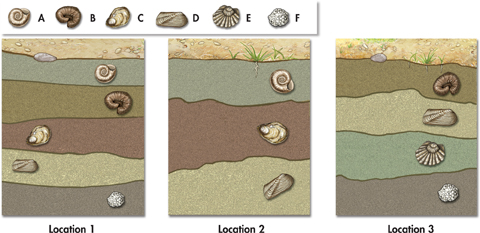Dating Earth's History
 How do we date events in Earth's history?
How do we date events in Earth's history?
The fossil record wouldn't be as useful without a time scale to tell us what happened when. Researchers use several techniques to date rocks and fossils.
Relative Dating Since sedimentary rock is formed as layers of sediment are laid on top of existing sediments, lower layers of sedimentary rock, and fossils they contain, are generally older than upper layers. Relative dating places rock layers and their fossils in a temporal sequence, as shown in Figure 19–3.  Relative dating allows paleontologists to determine whether a fossil is older or younger than other fossils.
Relative dating allows paleontologists to determine whether a fossil is older or younger than other fossils.
To help establish the relative ages of rock layers and their fossils, scientists use index fossils. Index fossils are distinctive fossils used to establish and compare the relative ages of rock layers and the fossils they contain. A useful index fossil must be easily recognized and will occur only in a few rock layers (meaning the organism lived only for a short time), but these layers will be found in many places (meaning the organism was widely distributed). Trilobites, a large group of distinctive marine organisms, are often used as index fossils. There are more than 15,000 recognized species of trilobite. Together, they can be used to establish the relative dates of rock layers spanning nearly 300 million years.
Radiometric Dating Relative dating is important, but provides no information about a fossil's absolute age in years. One way to date rocks and fossils is radiometric dating. Radiometric dating relies on radioactive isotopes, which decay, or break down, into stable isotopes at a steady rate. A half-life is the time required for half of the radioactive atoms in a sample to decay. After one half-life, half of the original radioactive atoms have decayed, as shown in Figure 19–4.

FIGURE 19–3 Index Fossils Each of these fossils is an index fossil. If the same index fossil is found in two widely separated rock layers, the rock layers are probably similar in age. Draw Conclusions Using the index fossils shown, determine which layers are “missing” from each location. Layers may be missing because they were never formed, or because they were eroded.
dTable of Contents
- Formulas and Equations
- Applying Formulas and Equations
- Mean, Median, and Mode
- Estimation
- Using Measurements in Calculations
- Effects of Measurement Errors
- Accuracy
- Precision
- Comparing Accuracy and Precision
- Significant Figures
- Calculating With Significant Figures
- Scientific Notation
- Calculating With Scientific Notation
- Dimensional Analysis
- Applying Dimensional Analysis




